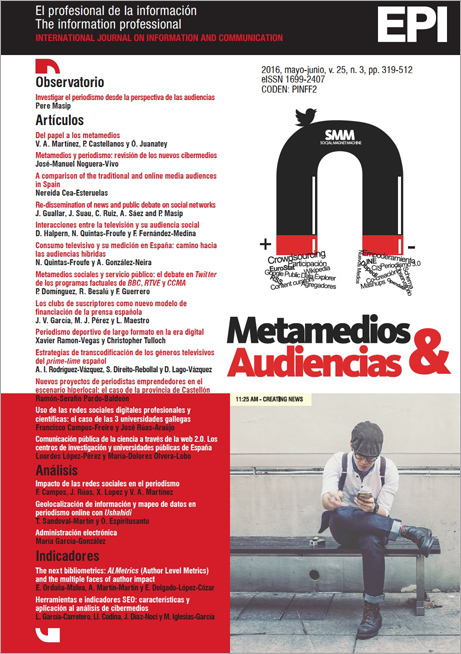Public communication of science through web 2.0. The case of research centers and public universities in Spain
DOI:
https://doi.org/10.3145/epi.2016.may.14Keywords:
Scientific communication, Public communication of science, Web 2.0, Social networks, Blogs, Scientific culture, Universities, CSICAbstract
This paper analyzes the use that the Spanish National Research Council centers (CSIC, by its Spanish abbreviation) and Spanish public universities make of web 2.0 in disseminating their research. The methodology used is based on an ad hoc checklist design for collecting data, focusing on three areas: the use of web 2.0 tools; connectivity (number of followers); and intensity (number of comments published). One significant finding was that both types of organizations made little use of social networks to disseminate their research. In the case of universities in 2014, around 40% were present on Facebook and Twitter, 22% on YouTube, and only 22% had blogs. In regard to CSIC centers, around 30% had Facebook and Twitter profiles, 18.9% were on YouTube, and 6.8% had informative blogs.
Downloads
Downloads
Published
How to Cite
Issue
Section
License
Dissemination conditions of the articles once they are published
Authors can freely disseminate their articles on websites, social networks and repositories
However, the following conditions must be respected:
- Only the editorial version should be made public. Please do not publish preprints, postprints or proofs.
- Along with this copy, a specific mention of the publication in which the text has appeared must be included, also adding a clickable link to the URL: http://www.profesionaldelainformacion.com
- Only the final editorial version should be made public. Please do not publish preprints, postprints or proofs.
- Along with that copy, a specific mention of the publication in which the text has appeared must be included, also adding a clickable link to the URL: http://revista.profesionaldelainformacion.com
Profesional de la información journal offers the articles in open access with a Creative Commons BY license.




